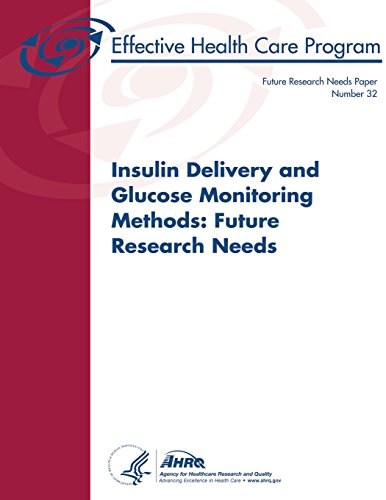Articoli correlati a Insulin Delivery and Glucose Monitoring Methods: Future...
Insulin Delivery and Glucose Monitoring Methods: Future Research Needs: Future Research Needs Paper Number 32 - Brossura

Diabetes mellitus is defined as a group of metabolic diseases characterized by hyperglycemia resulting from: defects in insulin secretion from the pancreatic beta cells; resistance to insulin action at the level of skeletal muscle, liver, and fat; or both. The prevalence of diagnosed diabetes in the U.S. is currently 7.7% and is expected to increase to nearly 10% by 2050. Type 1 diabetes, which accounts for 5 to 10% of all diabetes cases, is characterized by insulin deficiency and a need for daily insulin administration to sustain life, maintain normoglycemia, and maintain normal body weight and promote normal growth and development in children. Type 2 diabetes, which accounts for 90 to 95% of diabetes in the U.S., is the result of a combination of insulin resistance and impaired insulin secretion by the beta cells of the endocrine pancreas. In current practice, tight glycemic control is achieved through the use of physiological basal and meal-time (prandial) insulin that, when used together, mimic normal pancreatic function. Patients take these medications either as three or more daily injections [multiple daily injections (MDI)], or by external continuous subcutaneous insulin infusion (CSII) via a pump, which provides a more physiological means to deliver insulin. The challenges to use of SMBG are the associated pain, costs, behavioral and technical skills, required motivation, and intrusiveness. These challenges directly affect adherence to this technique and are barriers to tight glycemic control. In response to these issues, the health care industry has developed continuous glucose monitoring (CGM) systems that record blood glucose levels throughout the day and night with a significantly decreased need for fingerstick measurements. A CGM system, in conjunction with intensive insulin treatment, can be a useful tool to lower blood glucose values in adults who are at least 25 years of age and have type 1 diabetes. Success in lowering blood glucose levels depends on adherence to ongoing use of the device. CSII is currently recommended for patients with type 1 diabetes who are not achieving glycemic goals despite adherence to a maximum MDI regimen. Given new technologies in insulin delivery and glucose monitoring, clinicians are now faced with determining which patient populations benefit most from the use of CSII and rt-CGM in terms of improved glycemic, clinical, and patient-reported outcomes. Because both technologies are expensive and require extensive training and oversight by health care professionals, it is critical to determine how to select patients for their use. Our recent systematic review examined specific questions about the comparative effectiveness of insulin delivery and glucose monitoring methods. The review found that intensive insulin therapy delivered either by CSII and MDI is equally effective in lowering glycated hemoglobin (HbA1c) levels in adolescents and adults with type 1 diabetes. Intensive insulin therapy delivered by both methods resulted in similar rates of severe hypoglycemia for adolescents and adults with type 1 diabetes. The review also found evidence that rt-CGM is superior to SMBG in lowering HbA1c, without altering the risk balance of severe hypoglycemia, particularly among those who are compliant with wearing the monitoring device. Even though CSII and MDI without rt-CGM have similar effects on HbA1c, the addition of rt-CGM to CSII is superior to MDI/SMBG in lowering HbA1c. Thus, the addition of this monitoring method to SMBG and intensive insulin therapy can assist in achieving glycemic targets in individuals with type 1 diabetes. However, the review also identified several important gaps in the evidence. The objective of this report is to prioritize the needs for research addressing those gaps in the existing literature on management of insulin-requiring diabetes by engaging expert stakeholders using a modified Delphi method.
Le informazioni nella sezione "Riassunto" possono far riferimento a edizioni diverse di questo titolo.
- EditoreCreateSpace Independent Publishing Platform
- Data di pubblicazione2013
- ISBN 10 1492204536
- ISBN 13 9781492204534
- RilegaturaCopertina flessibile
- Numero di pagine62
Compra nuovo
Scopri di più su questo articolo
EUR 22,25
Spese di spedizione:
EUR 11,71
Da: Regno Unito a: U.S.A.
I migliori risultati di ricerca su AbeBooks
Insulin Delivery and Glucose Monitoring Methods: Future Research Needs: Future Research Needs Paper Number 32
Editore:
CreateSpace Independent Publishing Platform
(2013)
ISBN 10: 1492204536
ISBN 13: 9781492204534
Nuovo
Paperback
Quantità: 1
Da:
Valutazione libreria
Descrizione libro Paperback. Condizione: Brand New. 62 pages. 11.00x8.50x0.14 inches. This item is printed on demand. Codice articolo zk1492204536
Compra nuovo
EUR 22,25
Convertire valuta

